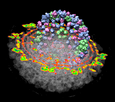
09-14-2005, 08:01 PM
|
 |
Senior Member
|
|
Join Date: Jan 2005
Posts: 23,174
Points: 193,617, Level: 100 |
Level up: 0%, 0 Points needed |
Downloads: 0
Uploads: 0
|
|

UCSF Chimera - highly extensible, interactive molecular graphics program
 UCSF Chimera home page
What can it do?
UCSF Chimera home page
What can it do?- Info from the Chimera website:
Molecular Graphics
- interactively manipulable stick, ball-and-stick, CPK, ribbon, and special nucleotide representations; molecular surfaces
- highly intuitive translation, scaling, and rotation; Side View tool for adjusting clipping planes and scaling
- interactive color editing in various color spaces (RGB, CMYK, etc.), including transparency
- ability to save high-resolution images for presentation and publication
stereo viewing (side-by-side and time-sequential)
Chemical Knowledge
- determination of atom types in arbitrary molecules, including non-standard residues
- ability to add hydrogen atoms
- high-quality hydrogen bond identification
- selection of atoms/bonds by element, atom type, functional group, amino acid category
- interactive bond rotation, distance and angle measurements
Sequence Viewer
The Multalign Viewer extension displays multiple sequence alignments, calculates and shows a consensus sequence and conservation histogram, and allows regions to be defined and colored. Structures opened in Chimera are automatically associated with a matching sequence. Structures can be superimposed based on the sequence alignment, and actual/predicted secondary structure features can be depicted on the alignment. When a region is defined by dragging within the sequence, the corresponding residues of the structure are highlighted. The color swatches behind the sequence names match the corresponding structures.
Volume Data
Volume Viewer shows three-dimensional electron and light microscope data, x-ray density maps, electrostatic potential and other volumetric data. Isosurfaces, meshes and transparent solid display styles are provided and thresholds can be changed interactively. The user can place markers and trace paths in the data.
Screening Docked Molecules
The program DOCK calculates possible binding orientations, given the structures of "ligand" and "receptor" molecules. Typically, a large database of small molecule structures is searched for compounds that may bind the receptor. The Chimera extension ViewDock facilitates interactive selection of promising compounds from the output of DOCK. The molecules can be viewed in the context of the binding site and optionally, screened by number of hydrogen bonds to the receptor
Collaboratory
The Collaboratory is an extension to Chimera that allows researchers at distant geographical locations to conduct a shared molecular modelling session over a standard network connection. All participants connected to a Collaboratory 'session' have equal control over the molecular structures, and any modification to the state of these structures (e.g. rotation, color change) is instantly seen by all other session participants. This creates a real-time research environment that allows colleagues on opposite sides of the campus, or across the globe, to share ideas and conduct their research as if they were looking at the same monitor.
Multiscale Models
The Multiscale extension allows Chimera to display large complexes such as virus capsids, ribosomes, and chromatin. It displays quaternary structure of PDB models and allows you to select subunits and show atomic resolution detail. Matrices are read from PDB files that specify the biological unit. Crystallographic packing can also be shown.
User-Driven Analysis
Users can easily import structure-related data into Chimera in the form of "attributes," i.e. values associated with atoms, residues, or models. The data can be imported with the Define Attribute extension and then visually represented as color ranges, varying atom sizes, or "worm" backbone depictions, using the Render by Attribute extension. Such data can also be manipulated programmatically in Chimera, and in fact Chimera was designed with extensibility and programmability in mind. It is largely implemented in Python, with certain features coded in C++ for efficiency. Python is an easy-to-learn interpreted language with object-oriented features. All of Chimera's functionality is accessible through Python and users can implement their own algorithms and extensions without any Chimera code changes, so any such custom extensions will continue to work across Chimera releases. Many programming examples are provided to assist extension writers.

|